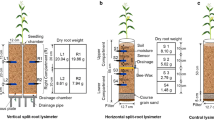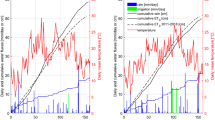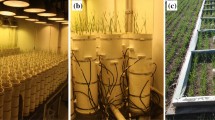Summary
The ability of water balance models based on the concept of Transpirable Soil Water to predict the occurrence of water stress and the need for irrigation was tested for several environmental conditions of the root system, to determine in which conditions errors are likely to be appreciable. The response of evapotranspiration, stomatal conductance and leaf water potential to soil water reserve was studied under three conditions: (i) in pots with maize plants, (ii) in the field with deep soil and the root system placed in favourable conditions, with wheat during a dry year and with maize during four years with contrasting climate, (iii) in the field, with soil compaction which disturbed the maize root system, decreasing its efficiency for water uptake, during four year. (i) In the pot experiment, where the volume of the Transpirable Soil Water (TSW) is well defined, the responses followed the hypothesis of water balance models. (ii) The soil depletion was higher than the calculated TSW during two dry years in the field, because of an appreciable contribution of the non-rooted soil layers to the water balance. As a consequence, evapotranspiration, stomatal conductance and predawn water potential did not decrease over the whole range of soil water reserve. Grain yield was no lower in those years than in the wet years, in spite of the fact that the soil water reserve was depleted. Thus, a water balance based on the TSW would have underestimated in these conditions the ability of plants to withdraw soil water, overestimating the necessity of irrigation. Predawn water potential gave, on the contrary, indications consistent with the responses of the stomatal conductance and the net CO2 assimilation. (iii) The water uptake by plants would have been overestimated in the case of compacted soil. Stomatal conductance was low even for high levels of the soil water reserve, except if the densely rooted top 0.1 m layer of soil was rewatered by irrigation. Water stress could not have been diagnosed in this case from indications of soil water potential or of pre-dawn water potential. These data confirm that some knowledge of the environmental conditions of the root system is necessary to determine if errors made using water balance models are likely to be appreciable, and to know if they lead to an underestimation or overestimation of the risk of water stress.
Similar content being viewed by others
References
Baker JM, Van Bavel CHM (1988) Water transfer through cotton plants connecting soil regions of differing water potential. Agron J 80:993
Bethenod O, Jacob C, Rode JC, Morot-Gaudry JF (1982) Influence de l'âge sur les caractéristiques photosynthétiques de la feuille de maïs, Zea Mays L. Agronomie 2:159
Bethenod O, Katerji N, Quetin P, Bertolini JM (1988) Efficience de l'eau d'une culture de pomme de terre (Solanum tuberosum L. cv Bintje). 1. Mise en évidence de la régulation du CO2 interne à l'échelle foliaire. Photosynthetica 22:491
Bruckler L, Lafolie F, Tardieu F (1991) Modelling the root water potential and soil-root water transport in the two-dimensional case. 2. Comparison with field experiments. Soil Sci Sco Am J (in press)
Caldwell MM, Richards JH (1989) Hydraulic lift: water efflux from upper roots improves effectiveness of water uptake by deep roots. Oecologia 79:1
Choisnel E (1985) Un modèle agrométéorologique opérationnel de bilan hydrique utilisant les données climatiques. In: Perner A, Riou C (eds) Les besoins en eau des cultures. INRA, Paris, p 115
Daynard TB, Duncan WG (1969) The black layer and grain maturity in corn. Crop Sci 9:473
Denmead OT, Shaw RH (1962) Availability of soil water to plants as affected by soil moisture content and meteorological conditions. Agron J 54:385
Dirksen C, Raats PAC (1985) Water uptake and release by alfalfa roots. Agron J 77:621
Dwyer LM, Stewart DW (1984) Indicators of water stress in corn. Can J Plant Sci 64:537
Eagleman JR (1971) An experimental derived model for actual evapotranspiration. Agric Meteorol 8:385
Eagleman JR, Decker WL (1965) The role of soil moisture in evapotranspiration. Agron J 626
Feddes RA, Kaba PJT, Bronswijk JJB, Halbertsma J (1988) Modelling soil water dynamics in the unsaturated zone. State of the art. J Hydrol 100:69
Gardner WR (1988) Soil properties and efficient water use, an overview. In: Taylor HM, Jordan WR, Sinclair TR (eds) Limitations to efficient water use in crop production. ASA, Madison USA, p 45
Lafolie F, Bruckler L, Tardieu F (1991) Modelling the root water potential and soil-root water transport in the two-dimensional case. 1. Presentation of the model. Soil Sci Soc Am J (in press)
Ludlow MM, Sommer KJ, Muchow RC (1990) Agricultural implications of root signals. In: Davies WJ, Jeffecoat B (eds) Importance of root to shoot communication in the response to environmental stress. BSPGR Monograph 21, Bristol, p 251
Masle J, Passioura JB (1987) The effect of soil strength on the growth of young wheat plants. Austral J Plant Physiol 14:643
Mengel DB, Barber SA (1974) Development and distribution of the corn root system under field conditions. Agron J 66:341
Molz FJ (1981) Models of water transport in the soil-plant system: a review. Water Resourc Res 6:1346
Mualem Y (1976) A new model for predicting the hydraulic conductivity of unsaturated porous media. Water Resourc Res 12:513
Perrier A, Itier B, Bertolini JM, Katerji N (1976) A new device for continuous recording of the energy balance of natural surface. Agric Meteor 16:71
Rosenthal WD, Arkin GF, Shouse PJ (1985) Water deficit effects on sorghum transpiration. In: Advances in evapotranspiration. St Joseph, Minneapolis USA, p 159
Ritchie JT (1985) A user-oriented model for the soil water balance in wheat. In: Day E, Atkin TK (eds) Wheat growth and modelling. NATO-ASI series, p 293
Slatyer RO, Mc Ilroy JC (1961) Evaporation and the principal of its measurement. In: Practical meteorology. UNESCO Paris 909 p
Tardieu F (1987) Etat structural, enracinement et alimentation hydrique du mais. III. Disponibilité des réserves en eau du sol. Agronomie 7:279–288
Tardieu F (1988a) Analysis of spatial variability of maize root density. I. Effect of discontinuous wheel compactions on spatial arrangement of roots. Plant and Soil 107:259
Tardieu F (1988b) III. Effect of wheel compaction on water extraction. Plant and Soil 109:257
Tardieu F (1990) Effets de l'état structural du sol sur l'enracinement. Que prendre en compte pour la modélisation? In: Boiffin J, Marin Laflèche A (eds) La structure du sol et son évolution. INRA, Paris, p 91
Tardieu F, Katerji N, Bethenod O, Zhang J, Davies WJ (1991) Maize stomatal conductance in the field; its relationship with soil and plant water potentials, mechanical constraints and ABA content in the xylem sap. Plant Cell Environ 14:121
Van Genuchten MT (1980) A closed-form equation for predicting the hydraulic conductivity of unsaturated soils. Soil Sci Soc Am J 44:892
Wayne SM, Green GC (1980) Water use by wheat and plant indicators of available soil water. Agron J 72:253
De Willigen P, Van Noordwijk M (1987) Roots, plant production and nutrient use efficiency. PhD Thesis Agricultural University Wageningen, The Netherlands
Zhang J, Davies WJ (1989) Abscisic acid produced in dehydrating roots may enable the plant to measure the water status of the soil. Plant Cell Environ 12:73
Author information
Authors and Affiliations
Rights and permissions
About this article
Cite this article
Tardieu, F., Katerji, N. Plant response to the soil water reserve: Consequences of the root system environment. Irrig Sci 12, 145–152 (1991). https://doi.org/10.1007/BF00192286
Received:
Issue Date:
DOI: https://doi.org/10.1007/BF00192286




